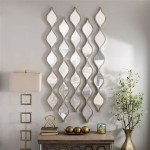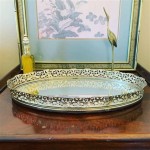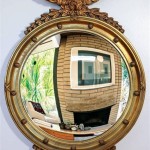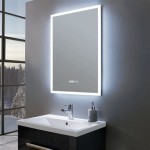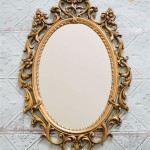Identifying Antique Mirrors
Antique mirrors offer a glimpse into the past, adding a touch of history and elegance to any space. However, distinguishing a genuine antique mirror from a reproduction requires careful observation and knowledge of key characteristics. Several factors, including the glass, backing, frame, and overall style, contribute to accurate identification.
One of the most significant indicators of an antique mirror is the presence of imperfections in the glass itself. Early mirror-making techniques resulted in slight distortions, bubbles, and waves within the glass. These imperfections, often referred to as "seeds" or "bubbles," are a direct result of the manufacturing process and are rarely found in modern mirrors. The glass itself may also have a slightly uneven thickness. While modern manufacturing strives for perfect uniformity, antique mirrors often exhibit variations in thickness across the surface.
Another key element to examine is the mirror's silvering. Antique mirrors were typically backed with a thin layer of silvering applied through a chemical process. Over time, this silvering can deteriorate, resulting in characteristic signs of age. Foxing, which appears as dark spots or patches on the mirror's surface, is a common sign of age and is caused by oxidation of the silvering. Another age-related effect is silvering loss around the edges, creating a darkened or haloed appearance. This is often more pronounced in older mirrors.
The backing of the mirror provides further clues to its authenticity. Early mirrors were often backed with wood, while later antique mirrors might have a backing made of paper or cardboard. Examining the backing material can help determine the mirror's approximate age. Evidence of old nails or tacks used to secure the backing can also indicate an older piece. Modern reproductions seldom replicate these historical backing methods.
The frame of an antique mirror is another essential element for identification. Antique mirror frames were often crafted from high-quality materials such as wood, gesso, or plaster, and exhibited intricate carvings or ornate detailing. Examining the frame's construction, style, and materials can offer valuable insights into the mirror's age and origin. Look for signs of hand-carving, age-related wear, and the use of traditional joinery techniques. Mass-produced modern reproductions often lack the fine craftsmanship and intricate detailing found in antique frames.
The overall style of the mirror can also contribute to its identification. Different historical periods favored distinct styles and shapes of mirrors. For example, Victorian-era mirrors often feature ornate frames with elaborate carvings, while Art Deco mirrors are characterized by geometric shapes and simpler designs. Researching different historical styles can help identify the approximate age and origin of a mirror. Matching the mirror's design elements to a particular period can provide valuable clues to its authenticity.
The size and weight of a mirror can also be indicative of its age. Early mirrors were often smaller and heavier due to the thickness of the glass and the materials used in construction. Larger antique mirrors, especially those with elaborate frames, can be quite substantial in weight. Modern reproductions often utilize thinner glass and lighter materials, resulting in a noticeable difference in weight compared to genuine antiques.
Assessing the condition of a mirror is crucial. While signs of age are expected in genuine antiques, excessive damage or poorly executed repairs can detract from the value and authenticity. Look for signs of restoration or repairs that may have been carried out over time. While some restoration is acceptable, significant alterations can diminish the historical integrity of the piece.
Provenance, or the documented history of ownership, is the most definitive way to authenticate an antique mirror. If a mirror comes with documentation tracing its ownership history, it significantly strengthens its authenticity. This documentation can include old photographs, receipts, or historical records that link the mirror to a specific time period or previous owner. While provenance isn't always available, it provides the most reliable evidence of a mirror's authenticity.
Consulting with reputable antique dealers or appraisers is highly recommended when attempting to identify and value an antique mirror. Their expertise and experience can provide valuable insights and help avoid costly mistakes. A qualified appraiser can offer an objective assessment of the mirror's age, origin, and value based on its characteristics and current market conditions. They can also identify any repairs or restorations that may have been performed.
Identifying antique mirrors requires careful observation and a thorough understanding of the characteristics that distinguish them from modern reproductions. Examining the glass, silvering, backing, frame, style, and overall condition of the mirror can provide valuable clues to its age and authenticity. Combining these observations with research and consultation with experts can help collectors and enthusiasts confidently acquire genuine antique mirrors.

Antique Mirrors A Guide To Identifying Collecting
Antique Mirrors A Buyers Guide Nimbus Antiques

Antique Mirrors A Guide To Identifying Collecting

Antique Mirrors A Guide To Identifying Collecting

A Guide To Identify Original Antique Mirrors Accent Mirror
Antique Mirrors A Buyers Guide Nimbus Antiques

Antique Mirrors A Guide To Identifying Collecting

Antique Mirror Identification Value Guide

Antique Mirrors A Guide To Identifying Collecting

How To Determine The Value Of An Old Mirror Hobbylark


